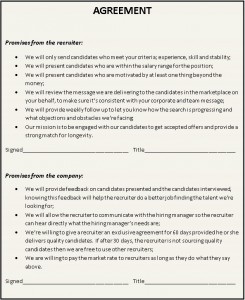
Let’s take a look at what a contingency search is. First, let’s look at a contingency search through the eyes of a company looking for talent to join its organization. Second, let’s look at it through the eyes of a recruiting firm looking for talented candidates on the company’s behalf. Maybe we can both do better.
The hiring company typically wants the best of both worlds. A company usually sources candidates itself and asks to see candidates from a recruiter to ensure seeing talent it might not see otherwise. Some companies engage several recruiters in order to have access to any and all candidates in the marketplace. Additionally, some companies try to lower the recruiter’s fee saying that other recruiting firms are willing to work for this fee, and ask that every recruiter do the same. By doing this, the company feels it is getting the best deal in the marketplace.
From the Recruiter’s Perspective
Now, let’s take a look at this scenario from the recruiter’s perspective.
Good recruiters close somewhere between 33% and 50% of the job orders they work on. When a company calls a recruiter with a job order and the company has two or three other firms engaged on the search, the recruiter’s odds go down in direct proportion to the number of recruiters assigned to the search. For instance, with three outside recruiters working on a search, the chances of placing a candidate for the company go down to somewhere between 8 and 12 percent.
It can be very frustrating and/or demotivating to call a candidate who looks like a great fit for the role only to hear “another recruiter has already called me about this position.” A client company may think this will motivate the recruiter to work harder, but in fact it can have the opposite effect. Some recruiters may feel compelled to stop and evaluate whether they should even spend time working on the search.
Discount Fee, Discount Effort
This leads us to the most important point of all. When a company has engaged the recruiting firm on a contingency basis, this is a very polite way of saying “straight commission” or pay “for performance.” You’ll find that any recruiter in the marketplace will take any job order you give them. The key question is: “Will the recruiter actively recruit candidates for your position that you need so very much to be filled?” If the recruiter has had to agree to a reduced fee, the decision could possibly come down to working on another opening with a different company or simply walking away.
The market is healthy with job orders, and the job market is quickly changing into a candidate-driven market. The recruiter is going to work with companies with which he or she has a good working relationship and the best chance of placing quality candidates.
Both parties want the same result, which is to find talented people to help the company manage its business. But in many instances there is a huge gap between what the client company wants (top talent for the organization) and what it actually receives from the recruiter. The company may not feel it is getting the attention or quality of candidates it needs, while the recruiter is frustrated by the lack of relationship with the company he or she is supposed to be representing.

Closing the Gap
So how do we close this gap? How do we change the relationship between the client company and recruiter to make it a win/ win for both parties?
Both sides need to make some promises to each other. The sample agreement provides a starting point for the promises, imposing obligations on both the recruiter and recruiting firm, as well as on the employer. The wording here offers a way to build the kind of relationship that does make it possible for both recruiter and client to come out winners.
Let’s change the way we do business, we all want the same thing. I’m ready, are you?